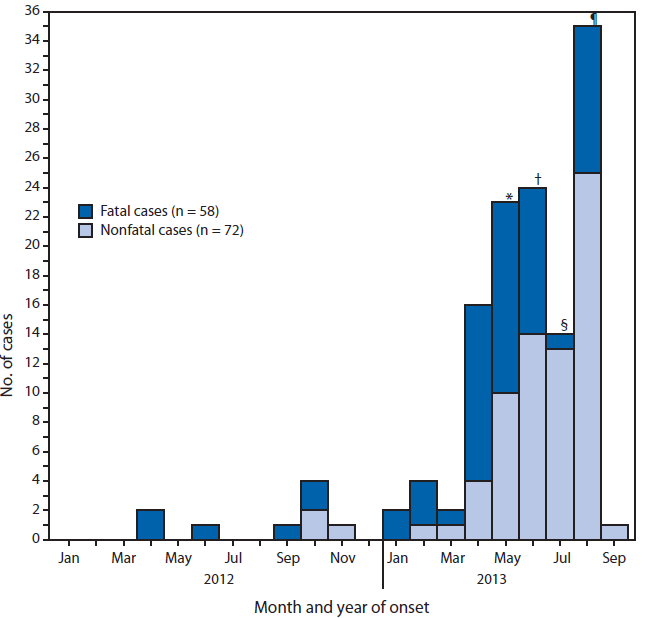Middle East respiratory syndrome coronavirus infection epidemiology and demographics
|
Middle East Respiratory Syndrome Coronavirus Infection Microchapters |
|
Differentiating Middle East Respiratory Syndrome Coronavirus Infection from other Diseases |
|---|
|
Diagnosis |
|
Treatment |
|
Case Studies |
|
Middle East respiratory syndrome coronavirus infection epidemiology and demographics On the Web |
|
American Roentgen Ray Society Images of Middle East respiratory syndrome coronavirus infection epidemiology and demographics |
|
FDA on Middle East respiratory syndrome coronavirus infection epidemiology and demographics |
|
CDC on Middle East respiratory syndrome coronavirus infection epidemiology and demographics |
|
Middle East respiratory syndrome coronavirus infection epidemiology and demographics in the news |
|
Blogs on Middle East respiratory syndrome coronavirus infection epidemiology and demographics |
|
Directions to Hospitals Treating Middle East respiratory syndrome coronavirus infection |
Editor-In-Chief: C. Michael Gibson, M.S., M.D. [2]
Overview
All reported cases have been linked to countries in and near the Arabian Peninsula. Most infected people either lived in the Arabian Peninsula or recently traveled from the Arabian Peninsula before they became ill. A few people became infected with MERS-CoV after having close contact with an infected person who had recently traveled from the Arabian Peninsula.
Epidemiology and Demographics
As of 16 June, 701 laboratory-confirmed cases of human infection with Middle East respiratory syndrome coronavirus (MERS-CoV) have been reported to WHO, including at least 249 deaths. Overall, 63.5% of cases reporting sex (n=677) are male and the median age is 47 years old (range 9 months-94 years old; n=695). An additional 113 cases occurring between 2012 and 2014 were reported by the Saudi Arabian Ministry of Health on 3 June 2014.[1]
 |
- The male-to-female ratio is 1.6 to 1.0, 63.5 % of cases are reported in males.
- Twenty-three (18%) of the cases occurred in persons who were identified as health-care workers.
- Although most reported cases involved severe respiratory illness requiring hospitalization, at least 27 (21%) involved mild or no symptoms.
- Despite evidence of person-to-person transmission, the number of contacts infected by persons with confirmed infections appears to be limited. No cases have been reported in the United States, although 82 persons from 29 states have been tested for MERS-CoV infection.
Shown below is an image depicting the number of cases of Middle East respiratory syndrome coronavirus infection (58 fatal and 72 nonfatal) reported to the World Health Organization (WHO) as of September 20, 2013, by month of illness onset during 2012-2013. As of September 20, 2013, a total of 130 cases from eight countries have been reported to WHO; 58 (45%) of these cases have been fatal.

Shown below is an image depicting confirmed cases of Middle East respiratory syndrome coronavirus infection (N = 130) reported to the World Health Organization as of September 20, 2013, and history of travel from in or near the Arabian Peninsula within 14 days of illness onset during 2012-2013. All cases have been directly or indirectly linked through travel to or residence in four countries: Saudi Arabia, Qatar, Jordan, and the United Arab Emirates.

References
- ↑ {{ cite web| title=Middle East respiratory syndrome coronavirus (MERS-CoV) – update June 2014| url=http://www.who.int/csr/don/2014_06_16_mers/en/ ]]
- ↑ Centers for Disease Control and Prevention (CDC) (2013-09-27). "Deaths and severe adverse events associated with anesthesia-assisted rapid opioid detoxification--New York City, 2012". MMWR. Morbidity and mortality weekly report. 62 (38): 777–780. ISSN 1545-861X. PMID 24067581.
- ↑ Centers for Disease Control and Prevention (CDC) (2013-09-27). "Deaths and severe adverse events associated with anesthesia-assisted rapid opioid detoxification--New York City, 2012". MMWR. Morbidity and mortality weekly report. 62 (38): 777–780. ISSN 1545-861X. PMID 24067581.